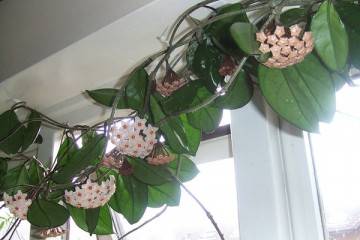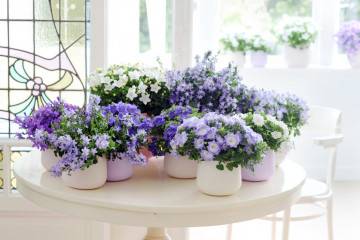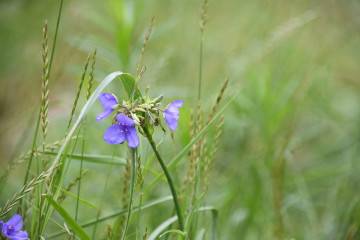Gloxinia - home care
Content:
Gloxinia is a bright flowering plant native to the tropics, but creating comfortable conditions for it in an apartment is not difficult. Various varieties are known as representatives of the hybrid gloxinia. Flowers differ in shade and shape, some are used to make bouquets.
What is this Gloxinia flower
Gloxinia flower is a perennial tuberous plant. In nature, it reaches 25 cm. Usually indoor gloxinia do not exceed 5 cm in height. The leaves of the plant are dense, velvety to the touch, are located close to each other, forming a small rosette.
Description and history of origin
Gloxinia flowers belong to the Gesneriaceae family. The plant owes its name to the scientist B.P. Gloskin. The famous botanist and doctor was born in France and worked in Germany. In its natural environment, the flower is found in the rocky areas of Mexico, the forests of Brazil and even in the famous Andes.
Houseplant types
In nature, there are about 20 plant species, but the most popular are the royal and beautiful gloxinia.
Gloxinia royal (Gloxinia Regina)
Gloxinia royal is a small plant that grows 10 cm in height. It has dark green leaves with light veins. In the light, they appear silvery. The flowers are quite large, purple in color. They resemble bells in shape.
Gloxinia fine (Gloxinia Speciosa)
The description of gloxinia is somewhat different. She has uniformly colored leaves, the veins slightly stand out against their background. Flowers have different shapes and colors. They can be red, purple, purple, there are varieties with a light border on the petals.
Gloxinia care
For healthy and blooming gloxinia to please the eye at home, home care should be based on a few simple rules.
Indoor temperature and illumination
Gloxinia loves bright, diffused sunlight. The best place for a flower pot is on the windowsill on the east or west side. With excessive light, burns will appear on the leaves, and the flowers will hide behind them. Lack of sun will also affect growth and development:
- flowering will be poor;
- the buds will grow small.
In summer, gloxinia feels comfortable at room temperature around 19-22 ° C.
Watering frequency, required humidity
How to water gloxinia at home:
- in spring and summer, with active growth and flowering, you need to water abundantly. The main thing is to make sure that the top layer of the soil dries out;
- after the end of flowering, watered less often, gradually stopping moisture.It is recommended to use water at room temperature, which must be pre-separated.
Spraying the plant is not recommended. It prefers high humidity, but you need to create it, avoiding water getting on the leaves and flowers.
Top dressing and soil quality
The first time to feed gloxinia is advised in April, care continues until August. Apply:
- potash and phosphorus fertilizers;
- organic mixtures such as mullein.
When feeding, it is advised to avoid excessive use of nitrogen. It leads to the formation of large leaves and nondescript flowers.
Planting a plant requires loose, breathable soil. If you do not want to buy a mixture for indoor flowers, you can prepare the soil yourself, taking leafy soil and peat in equal proportions, adding half the amount of sand.
Pot size
When choosing a pot, you need to build on the size of the tuber. The diameter of the container should be 5-6 cm larger than the rhizome. It should be taken into account that at the bottom there will be a drainage layer 3 cm high, and the soil should completely hide the tuber. There should be some room for root growth. Therefore, the flower is usually planted in fairly tall pots.
Pruning and replanting
Gloxinia does not require pruning. An exception is the formation of a long, thin stem. Pruning it will help a sturdy shoot grow.
Winter care
The dormant period begins in November and lasts until February.
How to care for gloxinia in autumn and winter:
- after flowering, the aerial part dies off. After that, you need to dig out the tubers;
- rinse, removing dead and damaged areas;
- move them to a cool and dark place. The temperature should be kept around 10 ° C.
With proper processing, after four months, young sprouts will become noticeable on the tuber; in the spring they can be planted in the ground.
Flowering features
Gloxinia pleases with colorful flowering every year. If this does not happen, it means that mistakes were made when leaving, or the plant is not given due attention.
A period of activity and rest
Gloxinia blooms in late spring and loses its last petals in autumn. Preparation for wintering begins in November. The plant requires less moisture, the leaves dry out. You should not cut them off, after dying off, they transfer nutrients to the tuber. During storage, it must sometimes be inspected; experienced growers advise to moisten the rhizome. It is planted after the appearance of buds.
Types and shape of flowers
Flowers resemble bells. Their buds are not lowered, but turned to the sides. There are terry and regular varieties. The former have more petals filling the inner part of the flower.
Reproduction methods
There are several ways to breed gloxinia at home. It is possible to grow not only with the help of cuttings, peduncles and seeds. Reproduction is carried out with a leaf and even part of it.
Seeds
How to grow gloxinia from seeds:
- Seeds can be purchased or obtained after artificial pollination. You need to transfer the pollen with a cotton swab. The formation of seed pods is a long process, they will appear in at least two months.
- The day before planting, they are soaked, then planted in containers, providing increased humidity and warmth. It is imperative to ventilate the planting material, periodically increasing the time in the air.
- Shoots will be visible in two weeks. After the appearance of two leaves, young shoots must be transplanted in separate containers so as not to damage the roots after subsequent transplants.
Sheet plates
Step-by-step instructions for planting gloxinia with a leaf:
- Select a healthy leaf during the formation of the buds, make cuts in the protruding places on the back. The instrument must be sharp and must be disinfected before the procedure.
- Put the sheet on the soil, pressing down at the cuts. Moisten the soil before doing this.
- Cover the container with foil, providing the plant with a greenhouse effect.
- After the roots appear, and behind them are small tubers, plant.
You can also divide the leaf into pieces and root them in the ground. The pieces are placed in the soil, placing foam under them. The sheets are covered with a film, periodically removing it for airing. No greenhouse effect is needed after rooting. In the spring, the resulting tubers are planted in the soil.
Growing problems, diseases and pests
Gloxinia is susceptible to infectious and bacterial diseases that can lead to its death. Also, the flower is affected by root rot, which is not always immediately recognizable. Of the parasites, spider mites and thrips can harm the plant.
How to fight
To protect gloxinia from diseases and pests, you need to monitor the temperature conditions and the frequency of watering.
If you get on the leaves during spraying, spots will appear on them, resembling burns. Therefore, you should be careful when creating conditions of high humidity.
Root rot is visible at the base of the stem. The defeat from the underground part of the plant goes to the surface. This leads to the death of the flower. The main reasons are stagnation of liquid at the roots with frequent watering and the use of cold water.
To combat insects, insecticides are used.
Gloxinia is a flowering plant that gets along well on any windowsill. Proper care and wintering are growing conditions for an unpretentious representative of the flora. It is the need to dig up the tuber and send it to a cool room during the cold season that is the main feature of gloxinia. Effort is rewarded with bright and long-lasting bloom.





















